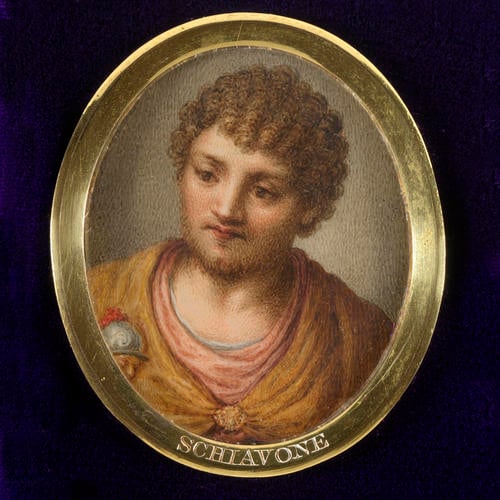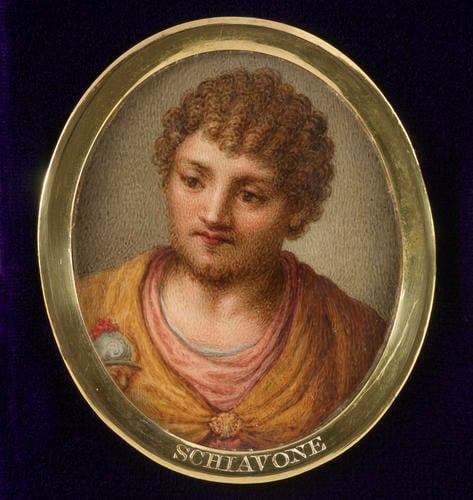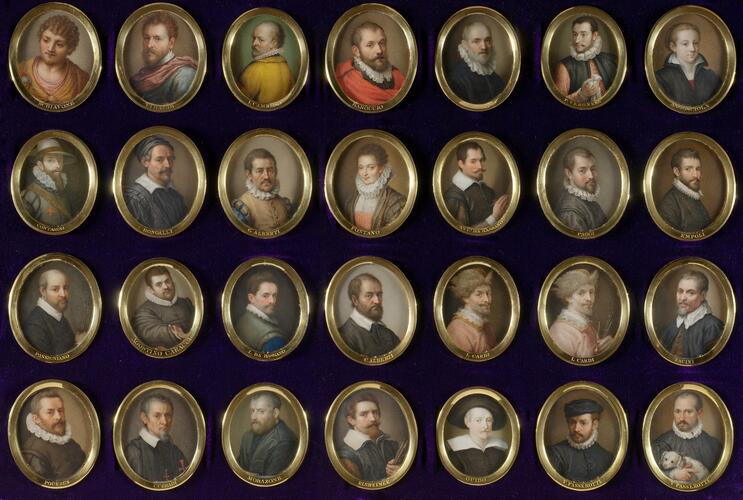Giuseppe Macpherson (1726-c. 1780)
Andrea Schiavone (c.1503-1563) c.1770-80
6.9 x 5.7 cm (sight) | RCIN 421284
-
Andrea Meldolla, called Lo Schiavone, came from the Romagna in Italy but his family had settled in Zara, Dalmatia, which is why he was known as 'Schiavone' (the 'Slav'). According to Carlo Ridolfi, his biographer, 'although he was an excellent painter, and certainly his way of doing things was wonderful, he was never in his life favoured by fortune'. By the 1530s, he was established in Venice and he may have been trained by Lorenzo or Giovanni Pietro Luzzo. Ridolfi suggests he had natural talent – 'one could say he was born with brushes in his hand' – which he developed by himself through copying the prints of Parmigiano and the works of Giorgione and Titian. Schiavone initially apparently only managed to get work painting the walls of houses, but then architects started using marble facades as the maritime salts destroyed plasterwork. He was reduced to painting the stalls of traders who set up under the porticos of S Marco and he earned less than rubbish collectors, despite his great talent. Ridolfi comments that his dress was very rough so no-one would guess that such talent lay beneath his horrible clothes. His earliest documented work was commissioned by Giorgio Vasari in 1540 in honour of Ottaviano de' Medici. By the late 1540s, Schiavone was part of Pietro Aretino's (the poet and satirist) circle, together with a group of innovative artists including Titian and Sansovino. According to Ridolfi, Schiavone's technique was such that you needed to look at his paintings from a distance, as close up you could see the brush strokes too much, but he was one of the best colourists in Venice. His paintings, however, pleased artists but not the general public. Titian gave him work in the library in S Marco and he painted three roundels for which Ridolfi felt he should have won a prize, but fortune passed him by yet again. His most characteristic works were fairly small religious or mythological pictures for private patrons. The Royal Collection contains a number of works by Schiavone.
This miniature is one of the collection of copies of 224 self-portraits by artists in the Uffizi Palace, Florence, that Lord Cowper, the art collector and patron, commissioned Giuseppe Macpherson (1726-1780) to paint. He presented the miniatures to King George III in two batches, in 1773 and 1786. Macpherson followed the original self-portraits quite closely, but copied only the head and shoulders. He inscribed the artists' names on the backs of the miniatures – several differ from those in the modern Uffizi catalogue, notably: Bazzi, Bellini, Campi, Annibale Carracci, Gabbiani, Masaccio, Metsys, Moroni, Pencz, Licinio, Schiavone and Spada. None of the miniatures is signed, apart from Macpherson's own self-portrait, which is inscribed: Giuseppe Macpherson / Autore della serie (Giuseppe Macpherson / Author of the series).Macpherson was born in Florence, the son of Donald Macpherson, a footman in the service of Alexander, 2nd Duke of Gordon. He was a pupil of Pompeo Batoni and painted miniatures and enamel portraits in Italy, France and Germany, finally settling in Florence. A James Macpherson is recorded in London and Paris in 1754 but it is not certain that this is the same person. He was described in 1776 as having a special talent for painting on enamel and as being 'almost the only painter in Europe who possesses this art to perfection'. He had a distinguished client list which included some of the crowned heads and dignitaries of Europe. In 1778, he was invited to add his own self-portrait to the famous painters in the grand duke's collection as it 'would do honour to Florence to enrich the collection with a work which shows that we still have some men of true merit' according to Giuseppe Pelli, director of the Uffizi at the time.
Provenance
Presented to George III by Lord Cowper
-
Creator(s)
-
Medium and techniques
Measurements
6.9 x 5.7 cm (sight)
Category
Object type(s)











